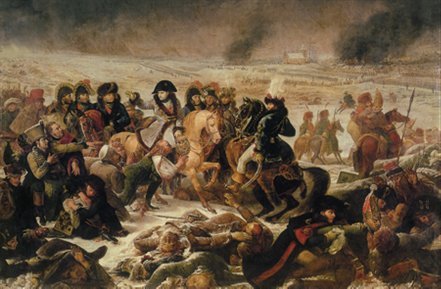Antoine Jean Gros,
Napoleon on the Battlefield of Eylau
(February 9, 1807), 1808. Oil on canvas, 521 x 784 cm.
Musée du Louvre, Paris.
Antoine Jean Gros, Baron Gros
(Paris, 1771-1835)
Gros’s father, who was a miniaturist, began to teach him to draw at the age of six. Towards the end of 1785 Gros chose to enter Jacques-Louis David’s studio, which he frequented assiduously, at the same time attending classes at the Collège Mazarin. In 1791, the death of his father, who had fallen on hard times during the Revolution, threw Gros upon his own resources. He now devoted himself wholly to his profession, and in 1792 competed for the Grand Prix, but was unsuccessful. About this time, however, on the recommendation of the École des beaux-arts, he was employed to paint the portraits of the members of the Convention. When the development of the Revolution meant that in 1793 Gros had to leave France for Italy, he supported himself in Genoa by the same means, producing a great quantity of miniatures. He visited Florence, and on returning to Genoa made the acquaintance of Josephine de Beauharnais, following her to Milan, where he was well-received by her husband. On the 15th November 1796, Gros was present with the army near Arcola when Bonaparte planted the tricolour on the bridge. Gros painted this moment, and showed from his treatment of it that he had found his vocation. Bonaparte at once gave him the post of “inspecteur aux revues”, which enabled him to follow the army, and in 1797 the general nominated him to the commission charged with selecting the spoils which should enrich the Louvre.
In 1799, having escaped from the besieged city of Genoa, Gros made his way to Paris, and in the beginning of 1801 took up his quarters in the Capucins. His esquisse (Musée de Nantes) of the Battle of Nazareth won the prize offered in 1802 by the consuls, but he never received it, owing, it is said, to the jealousy Napoleon felt for Junot. However the First Consul made up for this by commissioning Gros to paint his own visit to the pest-house of Jaffa. Bonaparte visiting the Plague-Stricken in Jaffa (11th March 1799) (Louvre) was followed by the Battle of Akoubir, 25th July 1799 in 1806 (Versailles), and Napoleon on the Field of the Battle of Eylau (9th February 1807) in 1808 (Louvre). These three subjects – the popular leader facing the pestilence unmoved, challenging the splendid instant of victory, heart-sick with the bitter cost of a hard-won field – made Gros famous. Gros was decorated and named Baron of the Empire by Napoleon, after the Salon of 1808, and under the Restoration he became a professor at the École des beaux-arts and Chevalier of the order of St Michel. However, as the army and its general separated from the people, Gros, called on to illustrate episodes representative only of the fulfilment of personal ambition, ceased to find satisfaction in this employment of his genius. Trained in the style of the Classicists, he was shackled by their rules, even when – by his naturalistic treatment of subjects, and use of picturesque effect in colour and tone – he seemed to run counter to them. In 1810 his Capitulation of Madrid, 4th December 1808 and Battle of the Pyramids, 21st July 1798 (Versailles) show that his star had deserted him. His Francis I and Charles V at the Abbey of Saint-Denis of 1812 (Louvre) had considerable success, but the decoration of the dome of the church of St Geneviève (begun in 1811 and completed in 1824), now the Pantheon, is the only work of Gros’s later years which shows his early force and vigour. The Departure of Louis XVIII from the Palais des Tuileries, night of the 20th March 1815 (Versailles), the Embarkation of the Duchess of Angoulême at Pouillac (Bordeaux), the ceiling of the Egyptian room in the Louvre, and finally his Hercules and Diomedes, exhibited in 1835, demonstrate that Gros’s efforts – in accordance with the advice of his old master, David – to stem the rising tide of Romanticism, served only to damage his once brilliant reputation. Exasperated by criticism and the consciousness of failure, Gros sought refuge in the unrefined. On the 25th June 1835 he was found drowned on the shores of the Seine near Sèvres. From a paper which he had placed in his hat it became known that “las de la vie, et trahi par les dernières facultés qui la lui rendaient unsupportable, il avait résolu de s’en défaire” (“tired of life, and betrayed by last faculties which rendered it bearable, he had resolved to end it”).
